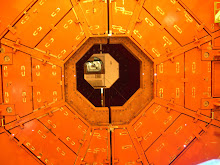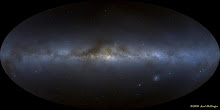 British CMS Team weighing the Higgs. Even one particle of dust could skew the results. That's why there are about 150 million sensors in the main experiments, 60 million tracker and pixel channels in the CMS alone, to nail the Higgs boson. And one large grocer's weigh scale just in case it's rather heavy.
British CMS Team weighing the Higgs. Even one particle of dust could skew the results. That's why there are about 150 million sensors in the main experiments, 60 million tracker and pixel channels in the CMS alone, to nail the Higgs boson. And one large grocer's weigh scale just in case it's rather heavy.And there are a lot more sensors and equipment to operate the LHC machine. Thousands of miles of electrical cable and fiber optics feeding four auxiliary control rooms for the experiments and one 5 million Euro main control room or CERN Control Centre (CCC), the Central Computer Room, plus the Tier Zero and Tier One Computer Grid based at CERN. Once operating, the annual LHC electric bill is estimated at $30 million, the power consumption about equivalent to the Canton of Geneva.
Rudiger Schmidt at CERN: "The LHC is a frightening complex accelerator--both from the hardware point of view and from operation."
Frightening and it hasn't been turned on yet. We have an idea of what to expect from the earlier posts on Fermilab's Tevatron. Electrical problems and faults for one, a tedious reality that has surfaced during LHC commissioning, besides some odd surprises. They have to be eliminated. At the LHC scale, even small faults can have potentially disastrous consequences.
One thing to remember is the 27 km LHC pipe when cooled to 1.9 K, near absolute zero, actually shrinks by about 10 meters. Odd problems and failures can crop up. When there's a quench, superconducting magnets affected need to be heated to discharge their energy or they will self-destruct. Last August when Sector 7-8 out of 8 did not expand properly during a warming test, there was a major failure in the beam lines. Some PIM's or plug in modules, like sliding copper fingers, buckled into beam lines, obstructing them in the pipe. Proton beams have yet to be injected, so there was no scare, and the problem was fixed in an ingenious way, some high tech with a lot of low tech. "Ping pong balls" with radio transmitters were blown through the system to locate the 6 defective PIMs.
With the LHC so big, there are other problems peculiar to it. You might laugh, but the Moon influences the size of the ring during tides, producing a variation of a millimeter, raising the Earth's crust 25 cm in the Geneva area. That causes a change in the beam energy of up to two tenths of a thousandth. Adjustments even at this tiny scale have to be made by physicists. N. Mokhov of Fermilab, now working on the LHC machine protection system, says, "The parameters of the LHC beam are so high that microscopic effects can be very destructive to the machine and to the detectors." Not to mention that unstudied anecdotal effect of Full Moons burning out electrical equipment and flooding hospital emergency rooms with accident victims. Can we get Mythbusters in on this one?
The nagging electrical problem affecting the entire LHC, is EMC or Electromagnetic Compatibility. Equipment, sensors, communications and computers, like nice cosy shielded conditions with proper and invariable power supplies, with no interference from high powered up to 8.2 Tesla magnets or odd electron cloud formations in the pre-accelerators or other nastier radiation. The LHC has been an EMC swamp, causing all sorts of equipment failures, noise and false readings that might be genuine that set alarms off all over the place. Even the electric passenger train system above ground emitted stray DC currents influencing the accelerators. That was fixed after a long investigation. Here's a bit more from http://ab-div-po.web.cern.ch/ab-div-po/Infos/Conferences/EMC%20Workshop/Fritz%20EMC_LHC_workshop_041122.pdf:
- Alarm systems - NDE's, false alarms, alarm avalanches, wrong alarms
- Multiple grounding and shielding of equipment
- Entire physics project failures, eg Microvertex detector cancelled
- Large computing effort to remove signal noise in postprocessing
- Fragile designs asking for "quiet environments"
- Teams accusing each other of making "noise"
- Destruction of 600 kW cryogenic compressor
- Beam loss and consequent magnet destruction in TT40
- Fire in experiment NA48
- Fire in BA3 because fire alarm showed a fire elsewhere
 Cointrin
Cointrin

























No comments:
Post a Comment